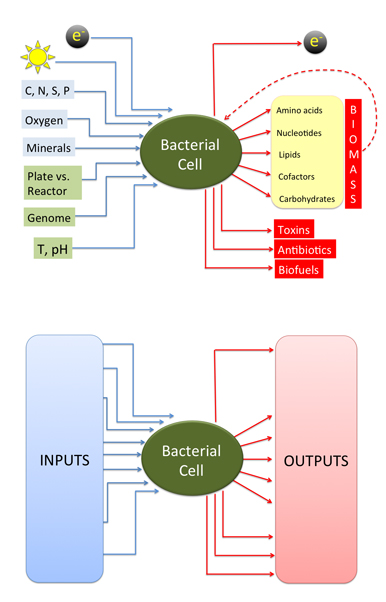New Research Could Help Trace Source of Bioterror Agents
By Mark Dwortzan

A bacterial cell receives several inputs from its environment, including the availability of different nutrients and the ambient temperature and pH. Based on these inputs, a bacterium controls its growth rate and molecular composition, which can be thought of as the output of the system. By combining experimental measurements and mathematical models, Paschalidis and Segre aim to gradually dcode this input-output relationship and thereby predict the output given the input or vice versa, enabling researchers to track the source of potential pathogens.
Through genetic manipulation or growth in the laboratory, microbes can be engineered for either harmful aims, such as anonymous anthrax attacks, or beneficial purposes, such as vaccines, fuel cells or pollution control systems. A better understanding of how the conditions in which a bacterial cell is grown impact its metabolism and biochemical composition could lead to new tools to help counter potential bioterror threats and advance the development of a wide range of peaceful applications.
Now an interdisciplinary team of systems engineers, computer scientists, microbiologists and biochemists—including Boston University researchers (Professor Yannis Paschalidis (ECE, SE) and Associate Professor Daniel Segrè (Biology, BME, Bioinformatics), as well as the University of Texas and Harvard University—seeks to establish clear links between bacterial cells’ growth conditions and their resulting composition by developing and testing advanced mathematical methods. Funded by a $7.5 million grant from the U.S. Army Research Office, the five-year project could lead to new ways to track the source of a bacterial pathogen, and to help discriminate between natural infectious outbreaks and the deliberate spread of pathogens.
Bacterial cells are typically grown in a nutrient-rich broth containing all the raw materials they need to grow and multiply. The growth medium and environmental factors particular to a lab, such as temperature or pH, constitute the growth conditions that collectively influence the metabolism and biochemical composition of a microorganism. To draw links between a bacterial cell’s growth conditions and its current composition, the researchers plan to model the cell as a system with inputs (growth conditions) and outputs (cell composition), and devise a functional mapping, or mathematical formulas, that transform inputs to outputs and vice versa.
Paschalidis plans to apply optimization techniques to produce these mappings.
“If we observe the cell composition, what can we say about the environment and growth factors impacting that composition?” he says. “The challenge in identifying the source of a bioterror attack is to solve this problem and infer the input from the output.”
Segrè, an expert in the use of mathematical models to drive biological discovery, will develop computer simulations of microbial metabolism and growth under a wide range of possible laboratory conditions. Based on these simulations and experimental measurements to validate their accuracy, Paschalidis will infer how various growth conditions impact the composition of a bacterial cell.
“The composition of the microbial cell may carry information on where it grew and how it evolved, like a hidden signature, that we will try to characterize and interpret,” Segrè observed. “If a bacterium grew under unusual circumstances, or was artificially evolved in a lab, this will likely be reflected in the cell composition.”
